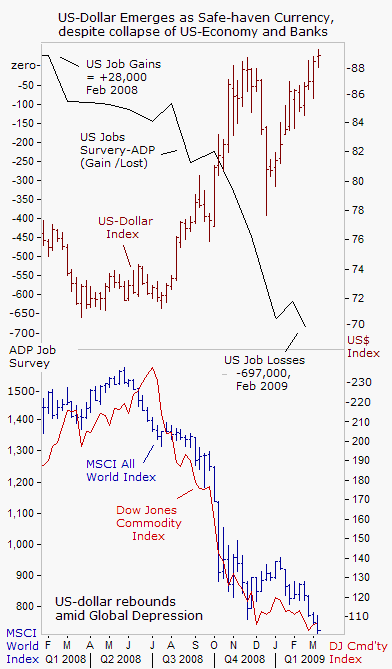|
|||
US-Dollar Shines in a DepressionGary Dorsch "De-leveraging" and "Risk Aversion" are the buzzwords cited by many currency analysts, to explain the puzzling strength of the US-dollar, which has climbed by more than 20% since last July, despite the widely held view, that top Wall Street banks are insolvent and only surviving on artificial life support, and with the flow of credit badly constrained, the US economy is spiraling towards a "Great Depression." De-leveraging in the $4-trillion per day foreign exchange market generally refers to the unwinding of speculative "carry trades." The enormous fortunes of Wall Street's aristocracy were built-up on the leveraging of debt, including "carry-trades," in order to buy exotic securities built around sub-prime mortgages, and other instruments of financial speculation. But when the US sub-prime mortgage crisis hit in the summer of 2007, traders began a massive de-leveraging process, or selling risky assets and buying back US-dollars and Japanese yen to pay back loans in those currencies. When global stock markets are plunging - the risk barometer shoots up, and carry traders scramble to close out losing trades, and will buy back the funding currency even if it offers a near zero-percent yield. Last year, the Japanese yen rose against all major currencies, even though Japan's economy was collapsing at twice the speed of the US-economy's demise, and the Nikkei-225 stock a record 42-percent. But after a year and a half of unwinding, the vast bulk of $1.5-trillion yen carry trade has probably been extinguished. Japan's mom-and-pop retail investors have also reduced their short yen positions versus higher yielding currencies, from 7-trillion yen in 2007 to 740-billion yen today. Indeed, since February 1st, the US-dollar has done a U-turn against the yen, climbing 10% higher to 99.6-yen this week.  The unwinding of risky positions in global commodities and stocks, coincided with the resurgence of the US-dollar against a basket of currencies, heavily weighted toward the Euro, (reflecting the Euro-zone's importance to US- trade). The US-dollar index almost reached the psychological 90-level this week, from around the 72-level last July, marching higher, even as the Dow Jones Industrials fell 11.7% in February, its worst performance since 1933, at the height of the Great Depression. According to this view, an enormous US-dollar carry trade is still in process of unwinding. The Dow Industrials have plunged below 7,000-points to the lowest in 12-years, following reports that the hedge fund manager AIG lost $61.7-billion in the last quarter of 2008, General Electric plunged to $6 /share, with $475 billion of outstanding debt, and General Motors is near Chapter 11. Yet all the troubles on Wall Street failed to tarnish the dollar's appeal among foreign central banks, who still view the guarantee of the United States government as a sure bet, and bought more than a third of the Treasury's debt auctioned in February. The staggering loss of 1.3-million US-jobs so far this year, hasn't knocked the dollar off its upward trajectory, perhaps due to a lack of better alternatives. Exports from Japan and other Asian powerhouses have quickly collapsed at a staggering pace due to the global downturn. Interest rate spreads in the Euro-zone bond markets are diverging to their widest levels ever against the German bund, amid warnings of the possible bankruptcy of weaker Euro-zone states. There has also been speculation of a potential breakup of the European currency union, - the Euro itself. To read the rest of this article, click on the link below: http://www.sirchartsalot.com/article.php?id=105 Mar 5, 2009 |
